Oxalis
Oxalis L.
Family: Oxalidaceae
Common names: sorrel (Eng.); suring (Afr.)
Introduction
Members of the genus Oxalis — with their brightly coloured delicate flowers, clover-like leaves and corolla lobes twisted in the bud — are mainly native to southern Africa and South America. Many people will know them for their sour-tasting stalks.
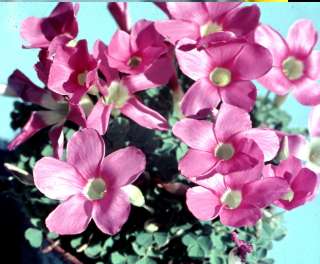
Description
Description
Oxalis, established by Linnaeus in 1753, is characterized by stem-less (acaulescent) or stemmed (caulescent) herbs or sub-shrubs with corms. This genus is the only one of the dicotyledonous genera to produce corms (tuberous bulb-like rootstocks). The species are perennials and low-growing, reaching heights varying from 0.05 to 0.3 m.

The leaves, borne in basal rosettes, are also characteristic of the genus. They are compound, usually trifoliolate (having three leaflets) with leaflets varying from more or less heart-shaped (broadly obovate and cuneate at the base) to narrowly obovate and predominantly stalked (petiolate). Petioles long and slender. Occasionally the leaves are sessile (without a stalk) or subsessile. The leaflets are often flushed with purple below and maybe hairy or have calli (thickenings). They display sleep movements, drooping or folding at night
Flowers are solitary or in umbel-like clusters on long, erect peduncles (stalks). They are radially symmetric (actinomorphic) with five free sepals (calyx) and a tubular corolla with five lobes (petals).
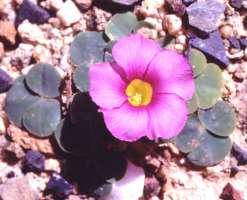
In some species the tube is long and slender, whereas in others it is rather short or either narrowly or broadly funnel-shaped. Similar to the leaves, the flowers close at night and in dull weather. The lobes of the corolla are prominently twisted in the bud, revealing delicate, glossy, brightly coloured petals as the corolla opens. White, rose-pink, pink, red, shades of purple and yellow are colours observed in the genusO. Oxalis is also characterized by obovate (inversely ovate), broadly obovate or suborbicular (almost with a ± circular outline), clawed corolla lobes.
Ten stamens, in two series, five long and five short, united at the base, and often golden yellow, are characteristic of Oxalis. Pollen grains produced in the anthers display different types. These pollen types proved to be significant in distinguishing different sections and species in the genus. The ovary is superior, 5-locular with five free styles. The fruit of Oxalis is a 5-lobed capsule, much longer than broad, with nearly parallel sides. The seeds, one to many, are explosively ejected.
Species Characters of the inflorescence (type), peduncular bracts, stem, leaves and leaflets (number, shape and texture) are used to distinguish different groups of species in the southern African members of Oxalis (Bayer 2000). A few examples are given of the two main sections below.
Conservation Status
Status
The genus needs assessment regarding rare and endangered species.
Distribution and habitat
Distribution description
Oxalis belongs to the family Oxalidaceae, a family of six genera and about 775 species, occurring mainly in the tropical but also in temperate regions of both the New and Old World. The family in southern Africa is represented by two genera: Oxalis and Biophytum. Oxalis comprises about 700 species world-wide, with centres of diversity in both southern Africa and South America. About 270 species occur in southern Africa. The members are widespread, but are mainly confined to Namibia and the Western and Eastern Cape in South Africa.
Species of Oxalis are mainly confined to the winter-rainfall Fynbos Biome. However, members also occur in the Savanna and Grassland Biomes where rain occurs in summer. The habitats where members of Oxalis are found vary from fynbos, grassland, forest, wetlands, moist, disturbed places, waste places, along watercourses, roadsides, rocky hillsides, clayey or sandy soils.
Derivation of name and historical aspects
History
The name Oxalis comes from the Greek oxis, which means acid, referring to the sour-tasting sap of some species.
Ecology
Ecology
O. corniculata, a native of Europe, is a troublesome, cosmopolitan weed of disturbed places or is often found along roads, in gardens or in pots.
Van Wyk et al. (2002) reported that "Oxalis species, for example, O. pes-carpae, and other plants containing soluble oxalic acid, are not really poisonous but they can lead to human and animal fatalities if excessive amounts are consumed. In southern Africa (as in many other parts of the world), outbreaks of oxalate poisoning have been reported, resulting from pastures infested with Oxalis or Rumex species. Under field conditions, sheep are mostly affected, but cattle and horses may suffer from degenerative conditions of the bones after prolonged exposure to low levels of oxalates". O. pes-caprae occurs mainly in the Western Cape and has become a troublesome weed in many parts of the world. However, the sour leaves of O. pes-caprae are an essential ingredient of waterblommetjie stew and other stews (Van Wyk & Gericke 2000).
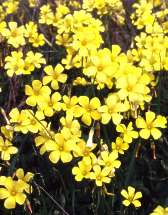
Uses
Use
Some southern African species of Oxalis are grown as ornamentals, for example, O. flava, O. lanata and O. purpurea. However, the horticultural potential of these delicate plants still needs to be explored.
Growing Oxalis
Grow
Members of the genus are propagated by their corms and seed. There are species to suit any situation — good or bad soil, full sunshine or complete shade or semi-shade — and they grow well, provided they get enough water. The plants spread rapidly and can be used as seasonal ground covers, but containers keep growth in check and prevent plants becoming weedy. Many of the species are dormant in the dry season. The genus is not known to be subject to pests or diseases in the garden, but the only reason for this may be that it has not yet been significantly cultivated (Du Plessis & Duncan 1989).
Species
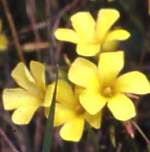
1a Species with a peduncle more than 1-flowered:
O. pes-caprae L. Geelsuring.
Stem-less; leaves usually basal, trifoliolate, leaflets heart-shaped, glabrous above, hairy beneath; flowers yellow, peduncle 3-20-flowered.
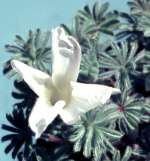
b Species with peduncle 1-flowered. The majority of species have 1-flowered stalks and may be grouped as follows:
2a Leaves unifoliolate (1) or leaves 4- or more-foliolate:
O. tomentosa L.f. Vingersuring.
Stem-less; densely silky hairy; leaflets 10-20, much longer than broad, base wedge-shaped; flowers white with a yellow tube [slide]

2b Leaves trifoliolate (with 3 leaflets):
3a Peduncular bracts at an articulation:
O. zeekoevleyensis R.Kunth .
Stem-less; leaflets heart-shaped, sparsely hairy below; flowers rosy lilac with a yellow tube.
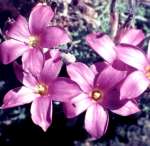
3b Peduncular bracts not at an articulation or lacking:
4a Plants with leafy stems, lower leaves sessile (without a stalk) or sub-sessile (with a short stalk)
O. hirta L.
Stems 0.05-0.3 m high; leaflets grey-green, long and narrow, inversely ovate, hairy below; flowers mauve, magenta or white with a yellow tube.
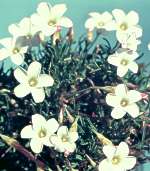
4b Leaves apically congested and distinctly petiolate:
5a Leaflets linear, folded together lengthwise:
O. versicolor L.
Stems up to 0.2 m tall, sometimes branching; leaflets often with marginal thickenings; flowers white with a yellow tube and reddish purple margins.

5b Leaflets oblong to heart-shaped, succulent (fleshy):
O. pulchella Jacq.
Stem-less; leaflets fleshy, almost flat with a ± circular outline; hairy below; flowers salmon or rose.

5c Leaflets non-succulent:
O. purpurea L.
Stemless; leaflets transversely obovate, ciliate, hairy and purple beneath, black-streaked when dry; flowers purple, yellow or white with a yellow tube.
References
- Bayer, B. 2000. In P. Goldblatt & J. Manning, Cape plants: a conspectus of the Cape Flora of South Africa. Strelitzia 9: 552-560.
- Dreyer, L.L. & Makwarela, A.M. 2000. Oxalidaceae. In O.A. Leistner, Seed plants of southern Africa: families and genera. Strelitzia 10: 432, 433.
- Du Plessis, N. & Duncan, G. 1989. Bulbous plants of southern Africa: a guide to their cultivation and propagation. Tafelberg, Cape Town.
- Van Wyk, B-E. & Gericke, N. 2000. People's plants: a guide to useful plants of southern Africa. Briza Publications, Pretoria.
- Van Wyk, B-E., Van Heerden, F. & Van Oudtshoorn, B. 2002. Poisonous plants of South Africa. Briza Publications, Pretoria.
Credits
Elizabeth Retief
National Herbarium Pretoria
August 2004
Plant Attributes:
Plant Type: Bulb
SA Distribution:
Soil type:
Flowering season:
PH:
Flower colour:
Aspect:
Gardening skill:
Special Features:
Horticultural zones






Rate this article
Article well written and informative
Rate this plant
Is this an interesting plant?
Login to add your Comment
Back to topNot registered yet? Click here to register.